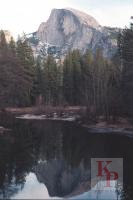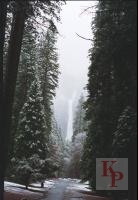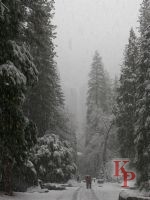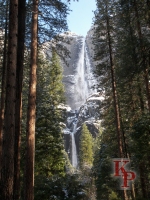Winter in Yosemite
Winter can be very nice or very difficult to visit Yosemite. There are fewer
people, fewer campsites available, fewer rooms, and much of the park may be
deep in snow (see the Tuolumne page for
more on that). This leaves the Valley and Wawona (and Badger Pass for skiing).
At 4000' the valley floor is usually snow free, and roads are quickly cleared
(though the days it snows can be slushy). Compared to Sequoia and Kings Canyon,
Yosemite is somewhat easier and more predictable in the winter.
It is important to remember that winter conditions in California are
controlled by the storms from the Pacific (or Gulf of Alaska).
With no storm, it is clear
and sunny, with a storm it can be heavy rain and/or snow. Plus, the type
of precipitation depends mostly on elevation. Rain in the valley, snow on
the valley rim. Or snow on the valley floor, rain at the entrance station
in El Portal. It is hard to plan far in advance, but if the forecast is for
no storms, there will be no problems. So, don't stay away, but be aware of
the conditions, both current and for the next several days. Driving can be
a problem (with or without chains) during and soon after the storms, but for
much of the winter the patches of ice are the greatest danger.
The lowest elevation route into the park is via CA 140 (El Portal,
originally called the all-weather highway). Wawona to
the Valley goes much higher is more likely to have snow for longer
periods.
If you define winter as snow, April is as more winter than November or
early December. But in April, the valley is barely freezing and the roads
become slush by afternoon. Usually there are no problems later in the
day, once the snow has stopped falling, but mornings can be icy.
Roads are plowed and the shuttle and tour buses use chains,
but no salt (or other chemicals) is used.
One big question is when does winter start and end? It varies, but the
high roads (Tuolumne and Glacier Point) usualy close in November or early
December and reopen in May (or June). When depends on the exact snow fall. The
snow depths in the backcountry usually peak in April. Closing dates depend
on how early the snow starts, opening dates depend on how much snow fell that
winter. Early closure does not mean late opening nor does late closure mean
early opening.
 Winter sometimes brings snow to the valley floor. The 4000' elevation
is low enough that it will not last long so enjoy it while you can.
Winter sometimes brings snow to the valley floor. The 4000' elevation
is low enough that it will not last long so enjoy it while you can.
|
 The falls usually are flowing a bit more than the late summer minimums,
and also have ice buildup (generally it can be 5-10 deg colder at the top
of the fall than the bottom (in whatever temperature scale you want to use)).
The falls usually are flowing a bit more than the late summer minimums,
and also have ice buildup (generally it can be 5-10 deg colder at the top
of the fall than the bottom (in whatever temperature scale you want to use)).
|
 Winter lasts longer than you might expect, April can still seem like
winter with fresh snow in the valley and ice on the falls.
Winter lasts longer than you might expect, April can still seem like
winter with fresh snow in the valley and ice on the falls.
|
 All the views from the valley are still there, with different lighting and
clouds.
All the views from the valley are still there, with different lighting and
clouds.
|
 And depending on the day and weather, you get very different views.
And depending on the day and weather, you get very different views.
|
 Mirror lake is much more in the shadows all winter so it retains light
snowfall longer than the other meadows.
Mirror lake is much more in the shadows all winter so it retains light
snowfall longer than the other meadows.
|
 You can experience several seasons in a week in April.
You can experience several seasons in a week in April.
|  Snowfall is not common, but can come at anytime.
Snowfall is not common, but can come at anytime.
|  The cold cuts the flow.
The cold cuts the flow.
|  Sunshine after snow fall is one of the best times.
Sunshine after snow fall is one of the best times.
|
 Return to my Yosemite home page.
Return to my Yosemite home page.
 Winter sometimes brings snow to the valley floor. The 4000' elevation
is low enough that it will not last long so enjoy it while you can.
Winter sometimes brings snow to the valley floor. The 4000' elevation
is low enough that it will not last long so enjoy it while you can.
 Winter lasts longer than you might expect, April can still seem like
winter with fresh snow in the valley and ice on the falls.
Winter lasts longer than you might expect, April can still seem like
winter with fresh snow in the valley and ice on the falls.
 Mirror lake is much more in the shadows all winter so it retains light
snowfall longer than the other meadows.
Mirror lake is much more in the shadows all winter so it retains light
snowfall longer than the other meadows.
 You can experience several seasons in a week in April.
You can experience several seasons in a week in April.
 Snowfall is not common, but can come at anytime.
Snowfall is not common, but can come at anytime.
 The cold cuts the flow.
The cold cuts the flow.
 Sunshine after snow fall is one of the best times.
Sunshine after snow fall is one of the best times.
 Return to my Yosemite home page.
Return to my Yosemite home page.